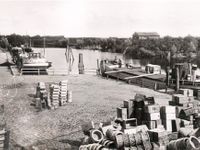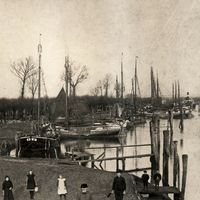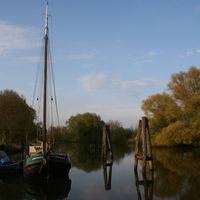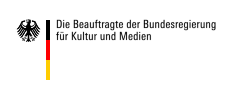53°32'25.8"N 9°41'27.9"E
Borstel Port and the Tjalk
History of Borstel Port
Beginning of the 9 th century :
Presumed ship’s landing place Zesterfleth at the mouth of the Zester into the Elbe, on the eastern point with St. Romanus Church.
Before 1275
Foundation of a master's court of the Archbishopric of Bremen in Borstel in the course of the Hollerkolonisation.
1412
After the disastrous Caecilian flood, the port was moved from Zesterfleht to Borstel.
In the 16 th century
Beginning of trade with Hamburg: grain, barley for brewery, horseradish, hemp, flax, since the end of the century Altländer fruits.
1651
Borstel Port is mentioned for the first time in documents. From 1675 onwards, the presence of two ship carpenters at the port is documented.
1750
Foundation of a skippers' association which all Borstel skippers belonged to. Journeys to Hamburg, Altona, Holstein, Bremen, shipbuilding in the Hartje dockyard was documented.
19 th century
Growth of the fruit trade. Journeys to London, Amsterdam, Copenhagen, Stockholm, Danzig, St. Petersburg. In 1824, 82 ships are registered in Borstel Port.
1861
Application to build the Wehrt'sche brickworks behind the Königsmarckhof. Brick exports from Borstel Port.
1896-1953
Steamship route between Borstel and Hamburg.
1970
Shutdown of Borstel Port in the course of dyking the Binnenelbe near Hahnöfersand. Reason for the repositioning of the dyke line after the storm surge in 1962.
According to the tax register, 59 ships with berthing rights were registered in Borstel Port at the end of the 18 th century. Until the beginning of the 20 th century, two dockyards were located along the docks: the Hartje dockyard since the 17 th century and the Ritscher dockyard, which moved here in 1911. Fruit was shipped from Borstel Port to Hamburg and Berlin and via the Lower Elbe to Holland, Great Britain and Scandinavia. Highlight of the social life was a Pentecostal market, which was celebrated on the harbour square and in the neighbouring inns by local and visiting skippers as well as many guests from the region.
The tjalk
The tjalk "Annemarie" is now located in Borstel Port. The farmer and skipper Johann Barfels transported fruit from the Lühe to the markets at the Elbe, especially to Hamburg, with a ship called "Frieda" between 1925 and 1938.
The tjalk is a flatboat of Dutch design.




